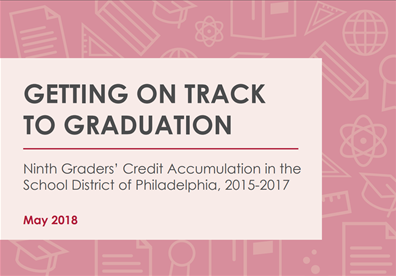By: Molly Crofton, Ruth Curran Neild
May 2018
Summary
Ninth grade is a critical juncture for students. Students who make a good transition to high school are likely to graduate within four years. Those who do not—who fail to earn as many credits as they should in ninth grade—face an elevated risk of dropping out of high school.
In 2018, the School District of Philadelphia (SDP) established a new Ninth Grade On-Track Definition. To be considered on track to graduation, a student completing the first year of high school must have earned at least one credit in each core subject (English, mathematics, science, and social studies), plus one additional credit from any subject. Annually, the District expects to report the percentage of students on track to graduation at the end of ninth grade.
This study applies the 2018 Ninth Grade On-Track Definition to students who were first-time ninth graders in the SDP during the 2015-16 or 2016-17 school years. The study examines how many students were on track to graduation, the characteristics of on-track and off-track students, and how on-track rates differ across high schools. Although the On-Track Definition was not in place at the time these students were in ninth grade, the analysis provides a benchmark against which progress can be measured and identifies characteristics of students and schools that might need additional support to start strong when they enter high school.
Key Findings
-
Approximately two-thirds of SDP high school students were on track to graduate at the end of their first year. The majority of ninth-grade students attempted credits in each of the four core subject areas. Most off-track students were enrolled in—but did not earn a passing grade in—at least one core course.
-
Some off-track students were missing just one requirement, while others were missing all requirements. More than 40 percent of the off-track students were missing one of the five required credits, while 22 percent were missing four or five of these credits. Among the students missing one requirement, science was the most common unmet requirement.
-
Female students were more often on track (72 percent) than male students (62 percent) at the end of ninth grade. Among off-track students, a higher percentage of males than females missed four or five requirements.
-
On-track rates differed by race, ethnicity, and gender. On-track rates ranged from 55 percent for Latino males to 90 percent for Asian females. Within each racial or ethnic group, a higher percentage of females were on track compared to males of the same race or ethnicity.
-
Students receiving special education services and low-income students were more often off track—and farther off track—than their peers. English learners were also more often off track than their peers but were missing fewer requirements than other off-track students.
-
On-track rates varied widely by school. At some SDP high schools, all of the students were on track at the end of ninth grade. At other schools, fewer than 50 percent of the freshmen were on track. Schools with lower on-track rates had a higher percentage of students that were far off track and were serving more special education students, English learners, and students from low-income families.
Policy and Implications
-
A focus on ninth grade could be an important component of a strategic approach to improving Philadelphia’s high school graduation rate. Students who start strong in ninth grade often finish strong—that is, they graduate from high school on time. Therefore, a good place for high school improvement efforts to focus is the first year of high school.
-
Increasing the ninth grade on-track rate will likely require different solutions for different types of students and schools. Data presented in this report can help schools and the community understand the characteristics of ninth graders who fall off track and the schools that may need more support to address their high off-track rates.
-
Implementing a multi-faceted, coherent set of evidence-informed solutions can keep more ninth graders on track to graduation. The ninth grade challenge is not unique to Philadelphia. Faced with similar off-track rates, other school districts across the country have sought to improve outcomes for ninth graders with new approaches to school organization, teacher staffing, curriculum and instruction, and student supports. It is important to implement a coherent, multi-faceted set of interventions.

